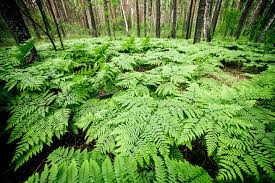Now, we come to the last group of non-flowering plants, the pteridophytes, included in this article. The most familiar plants of this group are ferns, commonly seen as houseplants, in parks, and in house landscapes alongside other ornamental plants.
Ferns are small plants with graceful, often delicate compound leaves. Due to their beauty and difficulty in propagation, they are considered highly valuable.
This article covers the general characteristics and life cycle of pteridophytes and the structure and morphology of some representative genera. Insights into early vascular land plants are derived from fossils of extinct members, such as Rhynia and Cooksonia, which were among the simplest and most primitive pteridophytes. One of the simplest living members of this group is Psilotum.
Pteridophytes are vascular plants, possessing roots, stems, and leaves. Like all vascular plants, they have water- and food-conducting tissues, xylem and phloem.
Various plant groups exhibit significant differences in the arrangement of xylem, phloem, and associated tissues. In pteridophytes, a natural progression from simple (primitive) to complex vascular tissue forms is observed.
Read Also: How often you need to Change Water in your Fish Farm
Life Cycle of Pteridophytes
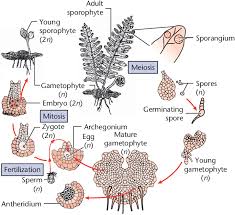
The pteridophyte life cycle has two distinct phases: the gametophyte and sporophyte, which alternate in succession. These two generations, which look different from each other, are termed heteromorphic.
Under normal circumstances, the gametophyte produces motile male gametes (sperms) and non-motile female gametes (eggs). Fusion of an egg and male gamete results in a diploid zygote, which divides to form the sporophyte.
The sporophyte produces haploid spores through meiosis, completing the life cycle when a spore germinates and produces a haploid gametophyte.
Unlike bryophytes, where the gametophyte is the dominant phase, pteridophytes have a dominant sporophyte that becomes independent of the gametophyte. The sporophyte exhibits a greater degree of complexity, organized into stem, root, and leaves, with vascular tissues (xylem and phloem) only present in the sporophyte.
The aerial parts are covered with a cuticle, and stomata on the epidermis enable gas exchange, allowing sporophytes to inhabit a broader range of environmental conditions than gametophytes.
General Characteristics and Relationship With Other Plant Groups
Pteridophytes display a wide range of variation in form, size, and structure. Most are herbaceous, with a few woody tree ferns. They may exhibit dorsiventral or radial symmetry, and their stems, which bear microphyllous or megaphyllous leaves, can be dichotomously or laterally branched.
The organization of the vascular cylinder (stele) in the sporophyte varies from simple, primitive types to more complex forms. Some members also contain vessels. Roots are generally adventitious, as the primary embryonic root is short-lived.
Spores are produced in specialized structures called sporangia, which are subtended by leaf-like appendages known as sporophylls. In some species, the sporangia are grouped into cones or strobili, or they may be produced within specialized structures called sporocarps.
Most pteridophytes are homosporous, producing one type of spore. However, some species are heterosporous, producing both microspores and megaspores. These spores germinate to form microgametophytes and megagametophytes, respectively.
Pteridophyte gametophytes are typically green, dorsiventrally differentiated, and thallose, with sex organs restricted to the ventral surface.
The archegonium is the female reproductive structure, while the antheridium is the male reproductive structure. Water is required for the opening of mature sex organs and fertilization, leading pteridophytes to be called amphibians of the plant kingdom.
Fossilization and Types of Fossils
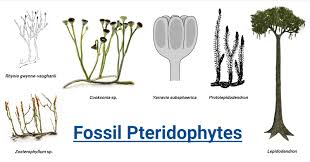
Fossils provide crucial insights into the origin of vascular plants. Fossils are the remains or impressions of organisms from the past, including evidence of organisms’ existence. The nature of fossilization depends on environmental conditions, and it is more likely to occur in organisms with stiff tissues or skeletons.
1. Fossilization Process
The fossilization process has occurred since sedimentary rocks began to form and continues in nature. In some cases, plant remains are preserved in situ, such as in swamps or small lakes, where low oxygen levels inhibit microbial decay.
In other cases, plant parts are carried by water and sink to the bottom of a lake, where they are less prone to decay. Fossils form when organic materials are gradually replaced by minerals, resulting in highly compressed remains.
2. Types of Fossils
1. Petrifaction: This is the best type of fossilization, where plant material is replaced, molecule by molecule, with minerals like silica or calcium carbonate, preserving the structure of the tissues.
2. Cast or Incrustation: Plant material is covered by sediment, which hardens over time, leaving an exact cast of the plant. Although the original plant material is absent, the cast reveals the surface features of the plant.
3. Impression: When a plant part leaves an impression on soft clay, which later hardens into stone, the external features of the plant are clearly preserved.
4. Compression: In this type of fossil, the plant’s organic remains are preserved in a highly compressed state. In good compressions, chemical treatments may reveal further details of the plant.
Fossil Nomenclature
Fossils often consist of plant fragments. Each fossil fragment is given a separate generic name, called a “Form genus,” based on the plant part it represents. For example:
Leaf: -phyllum
Fern-like frond: -pteris
Tree trunk: –dendron
Woody part: -xylon
Seed-like structure: -spermum, -carpon, -carpus
Microsporangium: -theca
Cone: -strobilus
Paleobotanists work to reconstruct the form, structure, and life of ancient plants from these fragments.
Morphology of Pteridophytes
Pteridophytes, a significant group of vascular plants, are classified into smaller divisions based on these traits. These include extinct Pteridophytes, known only from fossil records, and living Pteridophytes. Below are the major divisions:
Extinct Pteridophytes:
i. Rhyniophyta
ii. Zosterophyllophyta
iii. Trimerophyta
Living Pteridophytes:
i. Psilotophyta
ii. Lycopodiophyta
iii. Equisetophyta
iv. Pterophyta (also known as Polypodiophyta or Filicopsida)
This section will discuss representative types from some of these classes. The evolutionary progression shows that advanced, complex forms evolved from simpler, primitive forms. Therefore, the study begins with simpler forms before moving to the advanced ones.
Read Also: Benefits of Constructing a Fish Pond with Tarpaulin and Woods
Lycopodium
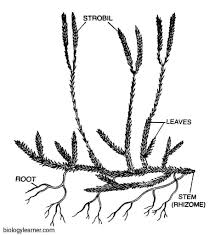
Classification:
Division: Lycopodiophyta
Class: Lycopsida
Order: Lycopodiales
Lycopodium, commonly known as club moss, is a large genus with about 180 species, 33 of which are found in India. These species are distributed worldwide in tropical, subtropical forests, and temperate regions. Some are abundant in hilly areas at higher altitudes, thriving in cool climates on moist, humus-rich soil.
The adult sporophyte is herbaceous, with varying habits. In tropical regions, Lycopodium species are typically pendulous epiphytes, while in temperate areas, they can be prostrate or erect. The plant usually grows between 30 to 60 cm in length.
The stem may be unbranched or dichotomously branched, later becoming monopodial. It is covered with microphylls, which are mostly spirally arranged, although some species exhibit whorled or decussate leaf arrangements.
Selaginella
Classification:
Division: Lycopodiophyta
Class: Isoetatae
Order: Selaginellales
Selaginella species are typically found in damp areas of tropical and subtropical regions. Some xerophytic species, inhabiting desert regions, are called “resurrection plants” due to their ability to recover after prolonged drought.
The plant can be prostrate, erect, or sub-erect, with some species forming delicate green mossy cushions, while others resemble ferns or grow vine-like, reaching several meters in height.
Branching in Selaginella is terminal and unequal, forming stronger and weaker branches. Rhizophores, cylindrical outgrowths that develop from angle-meristems at branching points, grow downward and give rise to adventitious roots.
The morphological nature of rhizophores has been debated, with suggestions that they are a type of root, stem branch, or a distinct structure. While rhizophores have root-like features, they exhibit some characteristics typical of stems, such as their exogenous origin and lack of a root cap.
Selaginella leaves are sessile with a single unbranched vein. These leaves are ligulate, and the ligule, present near the leaf axil, matures early in leaf development. A mature ligule is tongue- or fan-shaped, with a basal region made up of hyaline cells, a hemispherical region called the glossopodium, and elongated cells in the apical region.
Pteris
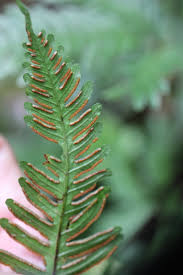
Classification:
Division: Pterophyta (also known as Filicophyta)
Class: Polypodiatae
Order: Filicales
Pteris is a widely distributed genus with about 250 species. It grows abundantly in cool, damp, and shady places in tropical and subtropical regions. In India, 19 species are recorded, with Pteris vitata being a low-level fern that produces new leaves year-round. Other species, such as Pteris quadriauriata and Pteris cretica, grow in higher altitudes, up to 2400 meters above sea level.
All Pteris species are terrestrial, perennial herbs with creeping or semi-erect rhizomes covered by scales. The leaves, called fronds, are the most conspicuous part of the plant. Most species have compound leaves, although some, such as Pteris cretica, have simple leaves.
In species like Pteris vittata, the leaves bear spore-producing structures on the underside, appearing as rows of brown dots called sori. Each sorus is a cluster of sporangia.
Pteridophytes are vascular plants with xylem and phloem but do not produce flowers or seeds, thus they are termed vascular cryptogams.
This group includes horsetails, ferns, and club mosses, with representative genera such as Cooksonia, Psilotum, Lycopodium, Selaginella, Equisetum, Pteris, Dryopteris felixma (Nigerian fern), and Marsilea. Some members of Pteridophytes are used for medicinal purposes and as ornamentals.
Do you have any questions, suggestions, or contributions? If so, please feel free to use the comment box below to share your thoughts. We also encourage you to kindly share this information with others who might benefit from it. Since we can’t reach everyone at once, we truly appreciate your help in spreading the word. Thank you so much for your support and for sharing!
Read Also: The Effect of Heat Stress on Animal Productivity
Frequently Asked Questions
We will update this section soon.

